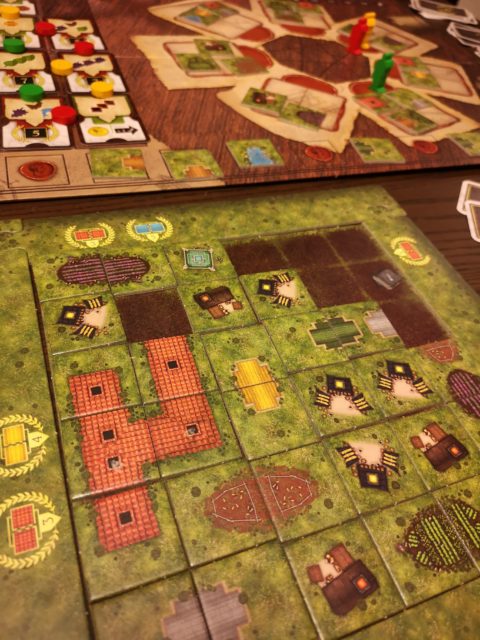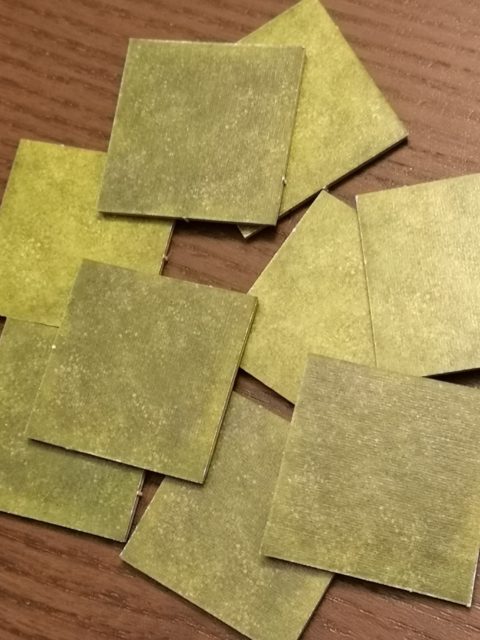Ah, the prolific Feld – so many designs, so little time for getting them to the table. One of his most recent, Carpe Diem, sort of dropped out of nowhere for me – I’d heard much buzz among local friends who are Feld aficionados but it wasn’t until BGGcon that I swung by the Ravensburger booth to see it set up, and was intrigued. I like Feld, and I love tile games – so this felt like a no-brainer for me. (Even when it’s not stretching too far for an interesting theme, because – let’s face it – there’s no big shortage of games set in Ancient Rome!) But, I digress – before I get too distracted, let’s seize the day.

A day in the life of a Roman Patrician, at that. What that means for you at the game table is a whole lot of planning and tiles. Central to the game is the main board, laid out so that one side is for the randomized scoring cards for the game, and the other a circle of “blueprint” spots that are populated with tiles. Players then each have their own player board – your “district” – in which you’ll slowly build up plots of land and buildings over the game. The game consists of 4 phases – which represent weeks, so each phase is 7 turns long (so in the end, you’re seizing 28 days I suppose!). Each phase gives you just enough time to build up your district and resources a little, aiming to claim something worthwhile out of the scoring cards – like any good Feld, there’s a nice sprinkling of ways to earn points during these phases, but there’s also set, consistent ways to score game-end to work towards too, so you don’t have to put all your bread in one basket.
The game is that straight-forward – of course, there’s decisions to make that will have an affect on your game, but it’s the simplicity of the actions that have me quite enthusiastic for this game, especially due to how easy it is to teach. Gaining tiles by moving your patrician around the board in limited ways is a really neat way of drafting, and I like that it allows you a little bit of strategy and planning ahead, and that you can break the rule a little by spending your bread resource tokens to go wherever you like! That last part has increasingly become important in my strategy, as it definitely allows for room to move where finishing up buildings and landscapes go, in order to have the resources you need come the end-of-round scoring (oh yes, and miss a scoring opportunity and you’ll get dinged 4 points!). But i’ve found I can generally always find something to help me along if someone beats me to a tile I have my eye on – especially those one-tilers like the fountains (bonus game end points) and the markets and bakeries (for a quick get of money or bread tokens).

Those little one tile buildings can also help you when you’re filling out your district, nestled among your plots of land and your villas. As well as the buildings and whatnot giving you resources for scoring during the game, there’s two other aspects of your district’s layout to take advantage of as you play. One – the bandolero track. As your district grows, you’ll consume spaces that have those tokens, bumping you up on the track which is of benefit for a couple of reasons – one, turn order in selecting scoring cards at the end of each phase, and two is trying to get up as high on it as you can as you’ll score the number in points at the end of the game. The other part of your district is the surrounding border, 4 random pieces jigsaw pieced together that will allow you to score bonus points if you situate certain types of landscapes and buildings at certain points.
That last aspect is just one of the great points of variability in this game, something that the game’s doing well and which is keeping me coming back. It’s the same vibe I get from another Feld (a favourite of mine), Castles of Burgundy – different dice rolls, different tiles, seeing what you can work with given the variability. Although I must admit, I do love the fact I’ll see all of the tiles available in Carpe Diem no matter what player count – and in CoB, there’ll just be some that don’t see the light of day in a lower player count. Seeing a different mix of tiles, scoring cards and district scoring bonuses gives me a different feel each time I play, which has been key to my enjoyment of the game. And honestly, it’s been weirdly difficult for me to put into words just why I love this game so much! Because it’s straight-forward and there’s no innovation in terms of theme it’s just this feeling, this je ne sais quoi where I am left feeling so satisfied at game end, no matter how difficult that particular game’s been for me.

I know I often will leave discussing art and quality of a game’s physical presence towards the end of my reviews. To me, it’s the bow that ties a game up, that sprinkles a little flavour, the “tszuj”, so to speak. Carpe Diem has some decent components (wooden resources are a nice touch, if a little on the sparse side) and the cards and iconography are clear. But the colour scheme and overall graphics tend towards drab, and let’s not get started on the poor distinction between the backs of tiles. None of that’s going to stop me, though! That board with the spread of tiles for the patricians to stroll around looks fab, and nothing is outwardly terrible, at least!
Let’s not leave it on that note, shall we? I do really encourage you to seize the day and give this new Feld a whirl. I love it when an established designer has me excited with a new release, and this is going to be a staple on my shelf between Trajan and Castles of Burgundy for the future.

A note to readers: Thanks for making it this far! We have an in-shrink copy of Carpe Diem to give away to one lucky fan. To enter, head over here. We’re limiting it to US/Canada for shipping cost reasons. Giveaway will close on March 8th, 2019.
—
Carpe Diem is a tile drafting and placement game for 2 – 4 players that takes approximately 45 – 75 minutes. Designed by Stefan Feld, the art is by Lalanda Hruschka and it is published by Alea and Ravensburger. Thank you so much to Ravensburger for the review copy, and a giveaway copy for our readers!
Comments
No comments yet! Be the first!